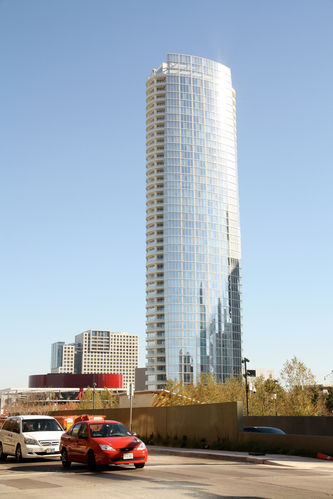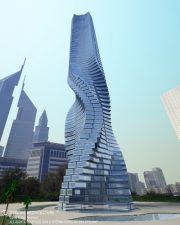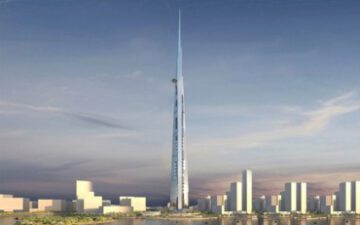 In London last week, a parabolic “death ray” of sunshine reflected off the city’s newest skyscraper burning cars and singing carpets in adjacent street level shops. It’s a cautionary tale for glass-clad towers in sun-intense Middle East, where robust assessment of a building’s impact on its environment is largely optional.
In London last week, a parabolic “death ray” of sunshine reflected off the city’s newest skyscraper burning cars and singing carpets in adjacent street level shops. It’s a cautionary tale for glass-clad towers in sun-intense Middle East, where robust assessment of a building’s impact on its environment is largely optional.
This structure at 20 Fenchurch Street, designed by New York-based Rafael Vinoly, was due to open next March, but London’s record-breaking summer weather has exposed a show-stopping design flaw.
The glare appears to be the result of a “value-engineering” exercise during construction that eliminated a feature from Vinoly’s original design. According to The Independent, narrow horizontal balconies were intended to act as sunscreens to mitigate glare, but they were deleted as part of a cost-cutting exercise.
Reflected sunlight raised temperatures to 158 °F; the landing points of these solar beams burnt past America’s Death Valley as the hottest-ever temperatures reported on Earth. Eyewitness John Sawyer told IBTimesUK, “We actually saw bike saddles melting directly opposite the building.”
Police have restricted area parking and a temporary street level scaffold has been erected to protect pedestrians. The glare is likely to remain for another month, at which point it’ll disappear as the solar angle shifts.
Tagged as the “Walkie-Talkie”, the tower is also being called the world’s first “fry-scraper”, but is it? There’s actually a growing catalog of modern buildings that act as architectural lasers.
 In 2004, Frank Gehry’s Walt Disney Concert Hall in Los Angeles made headlines when adjacent condo owners reported home temperature increases up to 15 °F due to sunlight reflecting off its polished metal cladding. The reflections were amplified by the concave shape of some of the exterior walls.
In 2004, Frank Gehry’s Walt Disney Concert Hall in Los Angeles made headlines when adjacent condo owners reported home temperature increases up to 15 °F due to sunlight reflecting off its polished metal cladding. The reflections were amplified by the concave shape of some of the exterior walls.
“You couldn’t even see and the furniture would get really hot,” resident Jacqueline Lagrone told the LA Times.
“You’d have to literally close the drapes and you’d still feel warmth in the house.” Blinding sunlight bouncing off the mirror-like surfaces also increased the risk of area traffic accidents. Building surfaces underwent computer analysis, and the offending surfaces were dulled by nearly $1 million of post-construction sanding, resolving the glare.
 In 2010, the hotel Vidara near Las Vegas was found to beam a “solar death ray” at its swimming pool. Pool toys melted and guests reported intense sunburns. “I’m sitting there in the chair and all of the sudden my hair and the top of my head are burning,” reported one. The glare reportedly raised the temperature more than 20°F on intensely sunny days.
In 2010, the hotel Vidara near Las Vegas was found to beam a “solar death ray” at its swimming pool. Pool toys melted and guests reported intense sunburns. “I’m sitting there in the chair and all of the sudden my hair and the top of my head are burning,” reported one. The glare reportedly raised the temperature more than 20°F on intensely sunny days.
The windows of the hotel, also designed by the Walkie-Talkie’s Vinoly, had been treated to minimize reflection, and nonreflective film was added after the problem was discovered, but it proved insufficient to deal with the desert sun. The hotel eventually erected a sail-like shade over the seared remains of the pool.
 And this year in Dallas, glare from the newly opened 42-story Museum Tower condominium wreaked havoc at the adjacent to Nasher Museum. According to the museum, glare from the condominium, designed by California architect Scott Johnson, distorts the viewing experience and damages art. It raises temperatures around the museum as much as 40 °F, killing off the bamboo gardens surrounding the facility and altering the precise natural daylighting conditions inside the galleries.
And this year in Dallas, glare from the newly opened 42-story Museum Tower condominium wreaked havoc at the adjacent to Nasher Museum. According to the museum, glare from the condominium, designed by California architect Scott Johnson, distorts the viewing experience and damages art. It raises temperatures around the museum as much as 40 °F, killing off the bamboo gardens surrounding the facility and altering the precise natural daylighting conditions inside the galleries.
If such serious design gaffs can occur in countries with established building codes, what’s the probability that skycrapers going up in developing nations will troubleshoot environmental impacts in advance of actual work? It could be that omnipresent air conditioning and tinted glass delays detection of increased heat and glare in Jeddah and Dubai. And as the Museum Tower proves, simple glass curtain wall can be a lethal as polished metal cladding.
Designer of the shimmering shards growing in Saudi and the UAE would be wise to consider this collateral damage as part of initial planning, or they too will be frying eggs on the sidewalk.




When I was at UofT in Toronto a fancy new tower library was built, then starting sinking. The architects somehow “forgot” to measure in the weight of books when they designed the building.
“Some architects just don’t think about the environment they build into”, like the biosphere we call planet Earth and with results far worse than melting asphalt.
Not news. In the mid-70’s a huge gold windowed building was built in Dallas, TX. It was known as the Exxon building at that time, I believe. It also incorporated a two level asphalt parking lot along side. The building reflected the heat of the TX sun all around it. After it’s construction the first summer all the cars in the parking lot sunk into the asphalt, burned interiors and so on. I suppose no one knew that it would happen again on a larger scale. Some architects just don’t think about the environment they build into. Last I saw the building was still standing, but all the parking structures had to be reworked in concrete.
Elle – You’re so right, seems history repeats itself in shorter and shorter cycles. Unfortunately, many architects design what the client wants instead of elevating those wants into something best suited to the site, and larger environment.